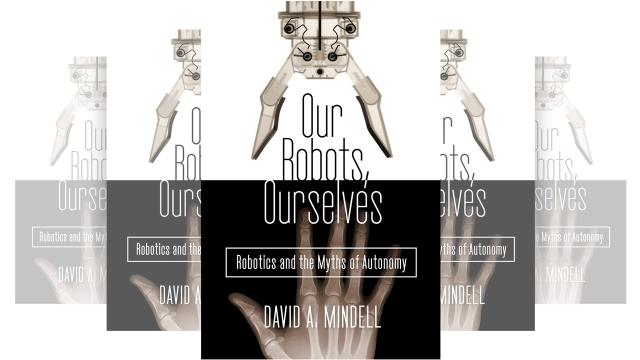War, as structured state-sponsored fighting and dying, has given rise to venerated professions to manage its risks and bound its ethical dilemmas. The nature of those professions, and the meaning of their experiences, changes when the human body is no longer present in the fight, fuelling a public debate.
This excerpt is taken from from Our Robots, Ourselves by David A. Mindell. It’s available today. Mindell debunks myths about cutting-edge robotics — including, in this passage, the idea that drones are truly autonomous.
This chapter, as a biography of the drone, explains how Predator came to be, and how it operates today, showing us remote operators deeply involved in the events they witness and affect. As with remote explorers undersea, their experience stems as much from social relationships as from the machinery itself. As in the airlines, the identities of the aircraft and those of its pilots have evolved together, each struggling for stability and recognition.
The U.S. Air Force’s Predator and Reaper remotely piloted aircraft (RPAs), have become the public face of “drone warfare.” Predator has gone far beyond an experimental stage and operated more than a million combat flight hours by 2010, and a million more by 2013. The air force has invested heavily in Predator, purchasing hundreds of aircraft to operate more than sixty combat air patrols (CAPs) (though losing more than seventy Predators to crashes). In 2012, the air force put more RPA operators through initial qualification training than pilots for fighters and bombers combined.
Each CAP, capable of keeping a continuous, twenty‑four‑hour presence over a target, is composed of four aircraft. Far from being “unmanned,” a CAP requires more than a hundred and fifty people to operate it. As of 2009, Predator operation required nearly 4 per cent of total air force personnel, and more than 9 per cent of its inventory of pilots. Predator A production ended in 2011, but Predator B — a more heavily armed version with twice the speed and range and ten times the payload, also known as Reaper — continues rolling off the production lines.
Predator’s distinctive shape, with its bulbous nose where a cockpit would normally be, its thin, long wings, and its downward‑canted tail hiding a pusher prop, has become an icon of a conflicted robotic era. It can loiter, nearly silent and invisible, over a distant battlefield for long periods, watch with intense focus through infrared cameras, and then unleash precisely targeted small bombs or missiles. This technology, depending on whom you ask, has become either the cutting edge of future warfare or the symbol of all that is wrong with American technological power, harbinger of an era of autonomous robotic surveillance. Whichever side of the debate you’re on, Predator has been a focal point.
Yet despite the profusion of press coverage, controversy, and public conversation, we know relatively little about what Predator operators actually do, and how the technology affects their experience of war. While often compared to manned fighters and bombers, Predator is not just a wannabe aeroplane, and its pilots are not wannabe pilots. Through an unusual and circuitous evolution, Predator has evolved into a new kind of aircraft, doing a new task, driven by new kinds of specialists. Much of that evolution has been led by Predator’s users, whether the people operating the aircraft from the ground, the people fighting in the theatre whom it supports, or commanders who deploy it in warfare.
Through these innovations Predator pilots feel deeply present on the battlefield, albeit in ways mediated by technology. “The Nintendo mentality is a detached mentality,” one operator observed, responding to criticisms of “video‑game” warfare that is “deceptively antiseptic.” “This stuff is real. I’m taking real lives. I’m shooting real weapons. And I have to be really responsible for my actions.”
Predator’s task is not that of the lone aircraft, the lone pilot, or the autonomous drone. Rather, it is as part of a global system, with many linked users and consumers operating from vastly different locations. For some, it represents a revolution in warfare, for others simply a new military tool in the arsenal, for still others the crossing of a troubling ethical line governing remote killing. But what Predator is not is an autonomous system, making decisions on its own and operating free of human control.
From Our Robots, Ourselves by David A. Mindell, published on October 13, 2015 by Viking, an imprint of Penguin Publishing Group, a division of Penguin Random House LLC. Copyright by David A. Mindell, 2015.
